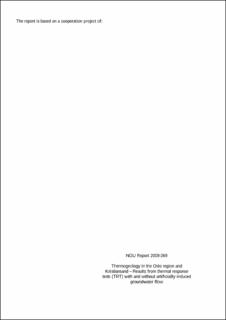| dc.contributor.author | Ramstad, Randi K. | |
| dc.contributor.author | Brattli, Bjørge | |
| dc.contributor.author | Liebel, Heiko T. | |
| dc.contributor.author | Huber, Kilian | |
| dc.contributor.author | Frengstad, Bjørn | |
| dc.coverage.spatial | FREDRIKSTAD | |
| dc.coverage.spatial | BÆRUM | |
| dc.coverage.spatial | OSLO | |
| dc.coverage.spatial | VIKEN | |
| dc.coverage.spatial | OSLO | |
| dc.coverage.spatial | AGDER | |
| dc.coverage.spatial | INNLANDET | |
| dc.coverage.spatial | KRISTIANSAND | |
| dc.coverage.spatial | MODUM | |
| dc.coverage.spatial | VESTRE TOTEN | |
| dc.coverage.spatial | RÆLINGEN | |
| dc.date.accessioned | 2020-07-15T07:42:35Z | |
| dc.date.available | 2020-07-15T07:42:35Z | |
| dc.date.issued | 2009 | |
| dc.identifier.issn | 0800-3416 | |
| dc.identifier.uri | https://hdl.handle.net/11250/2664695 | |
| dc.description.abstract | Thermal response tests (TRT) are widely used to measure the effective thermal conductivity and borehole resistance in a well. The gained data serve as the basis for the dimensioning of larger ground-source heat-pump installations with closed loop systems. The influence of groundwater flow on a TRT in fractured aquifers is not well understood. An attempt to quantify the influence of groundwater was done by pumping of groundwater from a nearby well during the TRT. The results were compared to a TRT in the same well without pumping. The effect of the groundwater flow is shown indirectly by the higher measured thermal conductivity and directly through the comparison of temperature profiles before and four hours after the TRT.\rFurthermore, seven TRTs were performed in the geologically diverse Oslo region and data collected from TRTs that were carried out by other companies. The data is compared with lab measured thermal conductivities from rock cores. Thermal conductivities measured by TRTs are by trend higher than those from rock cores but the dataset is still too limited for a statistical quantification of the add-on.\rThe data of this investigation indicate that thermal conductivity maps based on surface rock core samples cannot replace TRTs as there are too many variables linked to both measurements (TRT: presence of groundwater, several geological layers with varying mineral content along the well, thermal anisotropy etc.; rock core samples: punctual measurement, partly drained in the lab, thermal anisotropy etc.).\rBased on this study it is recommended to take standardized temperature profiles before and four hours after a TRT to get information about varying thermal properties of the ground along the well and about the presence\/absence of groundwater flow. | |
| dc.language.iso | eng | |
| dc.relation.ispartofseries | NGU-Rapport (2009.069) | |
| dc.rights | Navngivelse 4.0 Internasjonal | |
| dc.rights.uri | http://creativecommons.org/licenses/by/4.0/deed.no | |
| dc.subject | GEOTERMISK ENERGI | |
| dc.subject | GRUNNVANN | |
| dc.title | Thermogeology in the Oslo region and Kristiansand - results from thermal response tests (TRT) with and without artificially induced groundwater flow | |
| dc.type | Report | |
| dc.description.localcode | 55602 | |
| dc.source.pagenumber | 57 s. | |
| dc.relation.project | (328700) Termogeologi i sprekkeakviferer | |

